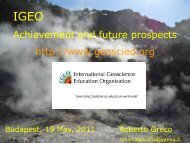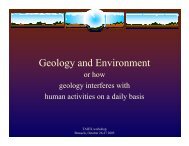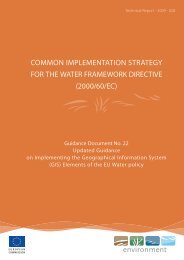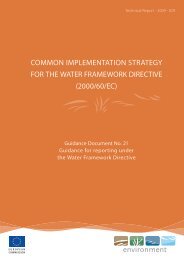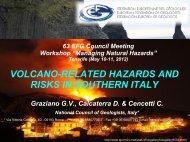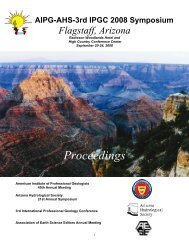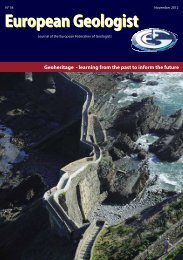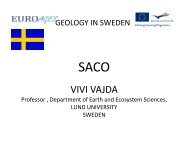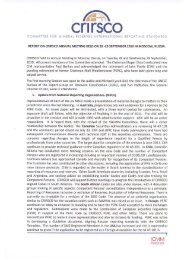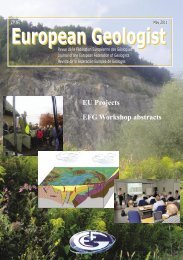EGM 30 download.pdf - European Federation of Geologists
EGM 30 download.pdf - European Federation of Geologists
EGM 30 download.pdf - European Federation of Geologists
Create successful ePaper yourself
Turn your PDF publications into a flip-book with our unique Google optimized e-Paper software.
All finalists received a certificate and agift, depending on the position obtained inthe ranking (Fig. 4), as stated in the website<strong>of</strong> the Olympics: (http://www.aepect.org/olimpiadasgeologia/index2010.htm).At the end <strong>of</strong> the awarding ceremony,a questionnaire was distributed among theparticipants which was completed by <strong>30</strong>students. Although we would have likedto have the views <strong>of</strong> all the students, webelieve that the results are representative<strong>of</strong> the general feeling. Broadly speaking, itis noteworthy that the Olympics were ratedwith a 4 or 5 on a scale <strong>of</strong> 1 - 5. Specifically,60% <strong>of</strong> survey respondents assessed theOlympics as excellent (4), and 40% consideredit more than excellent (5). It shouldbe noted that 100% would recommend thatthis activity should be carried our annuallyand 15% suggested that the exams shouldbe made in the four regional languagesexisting in Spain. Moreover, the reply toopen questions such as “your opinion aboutthe best thing <strong>of</strong> the Olympics” highlightedthe friendly atmosphere generated fromthe beginning.In view <strong>of</strong> these results, all members <strong>of</strong>the Organizing Committee and the Board<strong>of</strong> AEPECT consider that these resultssomehow compensate the important effortand dedication that have been made duringthis year to organize this first edition <strong>of</strong> theOlympics.Final thoughtsThe great success <strong>of</strong> this initiative leads theorganizers to propose that these Olympics<strong>of</strong> Geology should be held every year, tosupport the promotion <strong>of</strong> careers in scienceand hoping to add Geology as a new subjectduring the 5 th edition <strong>of</strong> the InternationalOlympics.The second National Geological Olympicswill also be held in Madrid to helpto consolidate the project, with the hope<strong>of</strong> rotation through different provinces inthe future.This second event (http://www.aepect.org/olimpiadasgeologia/index.htm)will use the facilities <strong>of</strong> CosmoCaixa inMadrid, a special place with an interactivescience museum. The aim is that 4finalists will then participate in the nextInternational Earth Science Olympiads(September 2011).The II Olympics <strong>of</strong> Geology will beheld to encourage students to know andunderstand Geology and Earth Sciencesbetter, to be more involved in PlanetEarth and the way geologists try to understandhow it works and to explain themany outstanding problems waiting forthe next generation to solve. Others willbecome more responsible citizens thanksto a deeper and extended knowledge <strong>of</strong> theplanet were we live.Earth itself is not in danger, but humanityneeds the planet and we need futuregeologists and scientists to find the solutionto living on Earth without making itinhospitable. We recognize that the greateffort <strong>of</strong> organizing the Spanish GeologicalOlympics has been adequately rewarded bythe enthusiasm <strong>of</strong> bringing geology closeto all our citizens - especially younger ones- who will be in the future responsible <strong>of</strong>the protection <strong>of</strong> our planet.AcknowledgementsWe would also like to thank the financialsupport <strong>of</strong> Repsol and AEPECT. Wehave also received staff and merchandisingsupport from IGME, CosmoCaixa,Fundación Ancestros, Geonatura, OfficialAssociation <strong>of</strong> Pr<strong>of</strong>essional <strong>of</strong> <strong>Geologists</strong>(ICOG), Complutense University <strong>of</strong>Madrid (UCM), University <strong>of</strong> Alcalá deHenares (UAH), and the Faculty <strong>of</strong> Geology<strong>of</strong> the UCM.Amelia Calonge GarcíaPresident <strong>of</strong> the Spanish Association for theTeaching <strong>of</strong> Earth Sciences (AEPECT)presidencia@aepect.orgwww.aepect.orgNews from GsFThe TOGO Project (West Africa )2007-2010The GsF TOGO project started in March2007, with a preliminary mission to thecountry, in order to evaluate, in a centralplateau North <strong>of</strong> Notse town, the possibility<strong>of</strong> supplying drinking water to a certainnumber <strong>of</strong> rural villages (total inhabitantsaround 10,000), where water was veryscarse.During the first visit, the project areawas defined and a preliminary hydrogeologicalsurvey <strong>of</strong> the plateau carried out- mainly granite outcrops <strong>of</strong> the basementwhereina sketch topographic map <strong>of</strong> thearea at 1:5.000 scale was drawn.The villages concerned are: Agbatitoe(the only Village close to the main NationalRoad), Simbao, Koledjikope, Avovo andYava.Shallow water wells had previouslybeen drilled in the area with negativeresults; where water was found, wells generallydry up during drought periods.The results <strong>of</strong> the hydrogeologicalinvestigation suggested that drillings hadto be deep, looking for productive faultsand fractures in the granite basement.In February 2009, the project enteredthe operational stage.Two deep water production wells havebeen drilled in the area <strong>of</strong> Koledjikopevillage, choosing the central portion <strong>of</strong>the plateau, an area known as Fadakope,where a Pilot Farm has been put in place,<strong>of</strong>fering working opportunities for the plateaupeople.The drillings, at depths <strong>of</strong> 75 and 98m, have proved to be very positive andhave been equipped with screen casing andelectric submergible pumps, working withsolar panels. The average water yield foreach well is around 10,000 litres/day.Simple water distribution systems,consisting <strong>of</strong> pipeline connections fromthe well to suspended plastic (polythene)water tanks and fountains with water taps,have been put in place for both drilledwells.Two water retention basins have beenexcavated (centre <strong>of</strong> the plateau and northernarea (Yava Village), with capacities <strong>of</strong>6,000 / 8,000 m 3 . They have proved to be<strong>of</strong> great benefit to the whole population<strong>of</strong> the surrounding villages, especially foragricultural purposes.During May and June 2010, a furthertwo deep-water wells (depths <strong>of</strong> 160 and115 m) were drilled in the Villages <strong>of</strong> Yava(North - population around 1,900) andAvovo (Centre-East - population 2,500).It is important to point out that in bothareas several drilling attempts had beenpreviously made with negative results.Both drillings have proved to be positive.Water was found at considerabledepths - 85 and 140 m in Yava and 70 and105 m in Avovo.The wells have been equipped withscreen casing and provided with electricsubmergible pumps and solar panels(manufactured by FLUXINOS Italia Srl- Grosseto. IT).Chemical analysis has proved the goodquality <strong>of</strong> water in both wells.The works have been completed withthe installation <strong>of</strong> water distribution systems,similar to those achieved in 2009.The people <strong>of</strong> the plateau can now benefitfrom the drinking water obtained fromthe four drilled wells.Considering the water retention basins,News and Events 2010<strong>European</strong> Geologist <strong>30</strong>43



